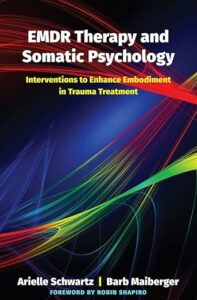Add-on eye movement desensitization and reprocessing (EMDR) therapy for adults with posttraumatic stress disorder who failed to respond to initial antidepressant pharmacotherapy (Journal of Korean Medical Science)
Efficacy of EMDR therapy among adults with PTSD who continued to be symptomatic after more than 12 weeks of initial antidepressant treatment.
Read MoreEffective Treatment of Veterans With PTSD: Comparison Between Intensive Daily and Weekly EMDR Approaches (Frontiers in Psychology)
Study of EMDR therapy for veterans with PTSD using two treatment formats: intensive twice daily vs. once a week EMDR treatments.
Read MoreEye movement desensitization and reprocessing (EMDR) (Springer, 2019)
A chapter on EMDR in the hands-on clinical guide on the relationship between trauma, dissociation, and eating disorders.
Read MoreEye movement desensitization and reprocessing versus treatment as usual in the treatment of depression: A randomized-controlled trial (Frontiers of Psychology)
Thirty patients with depression were treated to test whether EMDR plus treatment as usual (TAU) would achieve better results than TAU only.
Read MoreEMDR therapy and somatic psychology: Interventions to enhance embodiment in trauma treatment (W. W. Norton, 2018)
An integrative model of treatment that teaches therapists how to increase the client’s capacity to sense and feel the body.
Read MoreComparing the effect of eye movement desensitization and reprocessing (EMDR) with guided imagery on pain severity in patients with rheumatoid arthritis (Journal of Pain Research)
The current study aimed to compare the effects of EMDR and guided imagery on pain severity in patients with rheumatoid arthritis.
Read MoreEMDR as a treatment approach of PTSD complicated by comorbid psychiatric, somatic, and cognitive disorders: A case report of an older woman with a borderline and avoidant personality disorder (Clinical Case Studies)
A case report presenting EMDR treatment for PTSD with comorbid borderline and avoidant personality disorders in an older woman.
Read MoreA trauma-focused approach for patients with tinnitus: the effectiveness of eye movement desensitization and reprocessing – a multicentre pilot trial (European Journal of Psychotraumatology)
The aim of this trial was to assess effectiveness of a trauma-focused approach, EMDR, in reducing tinnitus distress.
Read MoreEffectiveness of an intensive treatment programme combining prolonged exposure and eye movement desensitization and reprocessing for severe post-traumatic stress disorder (European Journal of Psychotraumatology)
The aim of this study was to determine the effectiveness of an intensive trauma-focused treatment programme over 8 days for individuals suffering from severe PTSD.
Read MoreEMDR for Perinatal Mental Health with Bethany Warren, LCSW
Are there experiences in your life that you just can’t “get past”? What if these memories are tied to a pregnancy or postpartum experience?
Read More




